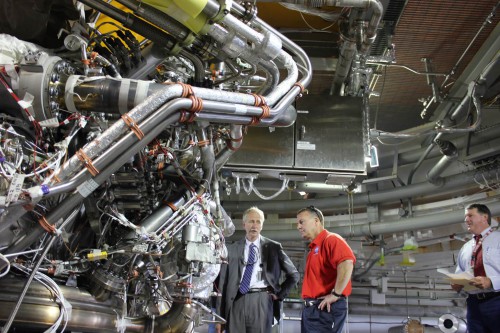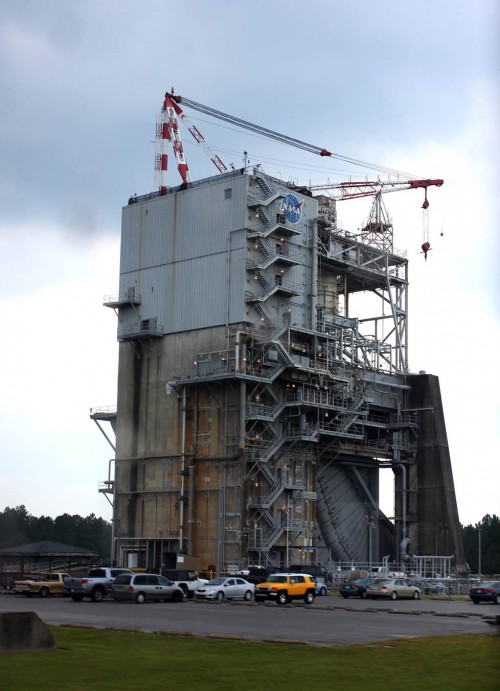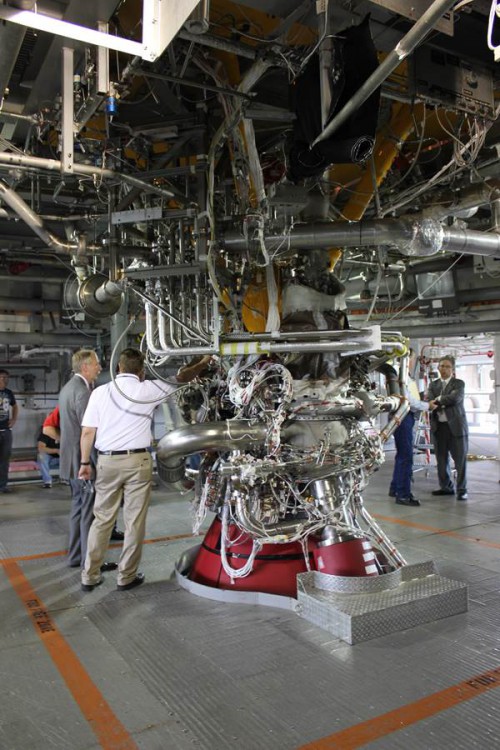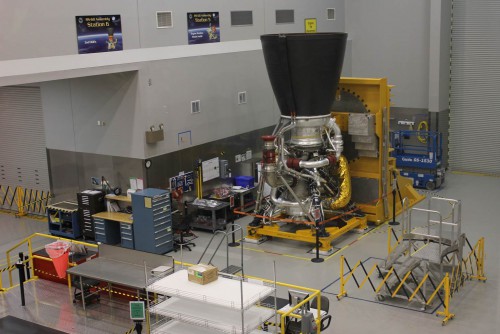
STENNIS SPACE CENTER, Miss — At NASA’s Stennis Space Center in Mississippi the space agency, along with contractors Boeing and Aerojet Rocketdyne, put the structures that build and test the machines that make space flight possible on display. The tour followed a ribbon-cutting ceremony held to mark the new Vertical Weld Center at NASA’s Michoud Assembly Facility, which is located in adjacent Louisiana. Both of these events were held on Friday, June 20. They highlighted a single truth: efforts to construct and launch NASA’s Space Launch System, or “SLS,” are moving forward.

Aerojet Rocketdyne’s Engine Processing Facility was the first stop of the tour. Just a few days after the announcement that the merger between Pratt and Whitney Rocketdyne and Aerojet was announced as being finalized, the building was festooned throughout with new signs denoting the company’s new moniker.
Guests were escorted to the second floor to a room with a large window that looked out onto the first floor and the RS-68 and RS-25 engines that littered the room. The NASA officials, aerospace company representatives, and elected officials that comprised the tour group were soon taken into the engine bay (it is an impressive site).
“Fourteen of these engines were used on the shuttle program. We’ve managed to build two more from components and parts that were leftover from shuttle,” said NASA’s Michael Kynard as he gestured to two RS-25s standing behind. “We’re trying to get the team to look at and to treat these engines as expendable.”
The RS-25 is more commonly known as the Space Shuttle Main Engine, or “SSME.” Three of these engines were mounted to the aft section of the shuttle. Under the shuttle program, the SSME powered NASA’s fleet of orbiters to various destinations in low-Earth orbit for more than three decades.
Editor’s note: This was a particularly memorable moment for me, as I had seen most of these RS-25 engines before. I last saw them at Kennedy Space Center’s Space Shuttle Main Engine Processing Facility shortly before they were boxed up and delivered to Stennis.
On the B-1 side of Stennis’ B-1 / B-2 test stand sits an RS-68 rocket engine. The RS-68 is employed on United Launch Alliance’s Delta IV family of launch vehicles. For proprietary reasons, close up imagery of the engine was not allowed.

It was a different story over at Stennis’ A-1 test stand. The J-2X engine was on full display, with engineers, officials, and members of the media hovering over the engine like worker drones attending to a queen bee. The J-2X will soon be evicted from her perch—a new tenant is taking up residence at A-1. The RS-25, as well as the prerequisite test equipment, will be placed within A-1 in preparation to test out various aspects of the venerable rocket for use on SLS.
Throughout Stennis work is going on. The various test stands are being renovated to test engines for use on SLS. Both NASA and Aerojet Rocketdyne workers could be seen bustling about, tending to the engines, welding together new elements, building the machines, and refurbishing the structures that could one day return humanity to the business of space exploration.
NASA currently plans to launch the first Orion Multi-Purpose Crew Vehicle in September 2014 on what has come to be called Exploration Flight Test 1. After this mission is conducted, various tests and flights will continue to validate the design. In 2017, the space agency is planning to launch the Block 1 version of SLS for the first time in an unmanned capacity. If all goes well, the first crewed flight could occur as soon as 2021.
The president had suggested that NASA retrieve an asteroid, deliver it to lunar orbit, and then send astronauts to it. Congress has since floated the concept that NASA should return to the mission it was directed away from with the cancellation of the Constellation Program—constructing a lunar base. Either way NASA views the tools being added to the space agency’s Michoud Assembly Facility (MAF), as well as at Stennis, as key to the space agency’s human space exploration ambitions. A crucial aspect of NASA’s efforts is modernizing both the facilities and tools it uses to help lower costs.
“What’s unique about these facilities is if you take a look at these, typically, there were three or four or five different tools required to do the same job you’re seeing with one tool here. What they showed you here today is they can do the entire weld in a single pass—that’s unheard of in the industry. The other thing it does is … the entire weld can be inspected with one tool, so you don’t have to move it around. That yields manufacturing flexibility. If you take a look outside where they do the domes, there were typically 10 or 15 tools that do what three tools do today. So they’ve taken advantage of modern manufacturing, state-of-the-art things to try to lower our overall operating costs that make this a very affordable rocket, even at low production rates,” said NASA Associate Administrator for Human Exploration and Operations William Gerstenmaier at MAF a few hours prior to the end of the tour.

This is the second part in a week-long series of articles detailing events at NASA’s Michoud Assembly Facility and Stennis Space Center. Stay tuned to AmericaSpace for articles as well as photo and video features about recent events at these two locations.
Want to keep up-to-date with all things space? Be sure to “Like” AmericaSpace on Facebook and follow us on Twitter: @AmericaSpace




2 Comments
2 Pings & Trackbacks
Pingback:Reviews and Hardware Signal Progress for NASA’s Space Launch System « AmericaSpace
Pingback:Final J-2X Test-Fire Conducted at A-1 Test Stand, NASA / Aerojet Rocketdyne Ready to Test RS-25 « AmericaSpace